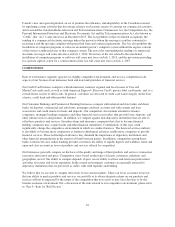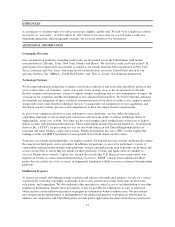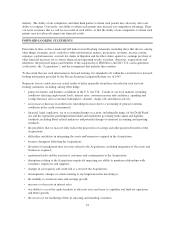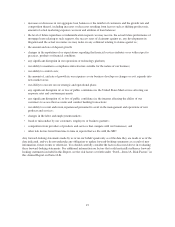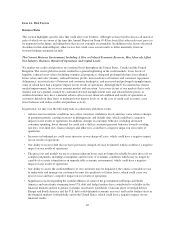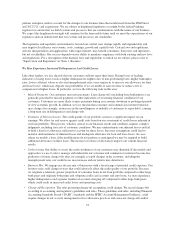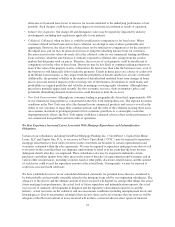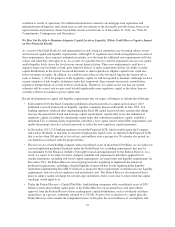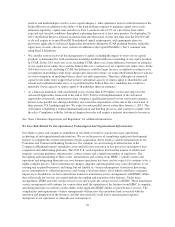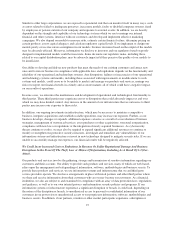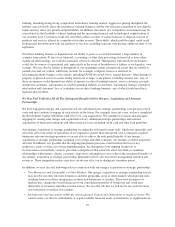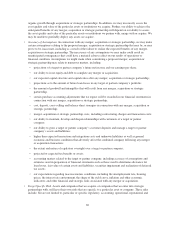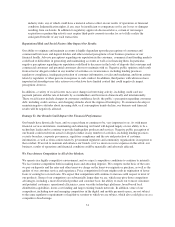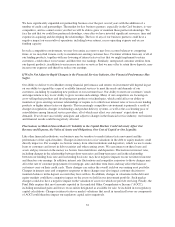Capital One 2013 Annual Report Download - page 42
Download and view the complete annual report
Please find page 42 of the 2013 Capital One annual report below. You can navigate through the pages in the report by either clicking on the pages listed below, or by using the keyword search tool below to find specific information within the annual report.The Dodd-Frank Act, as well as the related rules and regulations adopted by various regulatory agencies, could
have a significant adverse impact on our business, results of operations or financial condition. The Dodd-Frank
Act is a comprehensive financial reform act that requires, among other things, enhanced prudential standards
(including capital, liquidity, risk management, single-counterparty credit exposure limits, early remediation, and
resolution planning), enhanced supervision (including stress testing), prohibitions on proprietary trading and
investments in covered funds (referred to as the “Volcker Rule”) and increased transparency and regulation of
derivatives trading. The Dodd-Frank Act also provides heightened expectations for risk management and
regulatory oversight of all aspects of large financial institutions, including us. Many aspects of the law remain to
be implemented under the rulemaking and regulatory authority of the SEC, the CFTC and federal banking
regulators. The Dodd-Frank Act also created the CFPB, which regulates our businesses with respect to our
compliance with certain consumer laws and regulations.
Although it is clear that the Dodd-Frank Act and implementing regulations materially impact large financial
institutions like us, the rulemaking process has been progressing slowly, and we may not experience the ultimate
impact of the Dodd-Frank Act for years. Though some aspects of the Dodd-Frank Act may significantly impact
our financial condition or results of operations, other aspects of the law may not apply to us. Nevertheless, the
law has increased our need to build new compliance processes and infrastructure and to otherwise enhance our
risk management throughout all aspects of our business. The cumulative impact includes higher expectations for
capital and liquidity, as discussed in more detail below under the header “We May Not Be Able to Maintain
Adequate Capital Levels or Liquidity, Which Could have a Negative Impact on Our Financial Results,” and
higher operational costs, which may further increase once regulators fully implement the law. In addition, U.S.
government agencies charged with adopting and interpreting laws, rules and regulations, including under the
Dodd-Frank Act, may do so in an unforeseen manner, including ways that potentially expand the reach of the
laws, rules or regulations more than initially contemplated or currently anticipated.
Some rules and regulations may be subject to litigation or other challenges that delay or modify their
implementation and impact on us. For example, rules implementing the Dodd-Frank Act’s requirement that the
amount of any interchange fee received by a debit card issuer with respect to debit card transactions be
reasonable and proportional to the cost incurred by the issuer with respect to the transaction are currently subject
to challenge. It is unclear how the ruling and appeal will impact the Federal Reserve’s interchange fee rules.
Future changes in the Federal Reserve’s interchange fee rules could adversely impact revenue from our debit
card business.
Under various state and federal statutes and regulations, we are required to observe various data security and
privacy-related requirements, including establishing appropriate information security standards and safeguards,
data security breach response programs and properly authenticating customers before processing or enabling
certain types of transactions or interactions. Future federal and state legislation and regulation could further
restrict how we collect, use, share and secure customer information. The failure to observe any one or more of
these requirements could subject us to litigation or enforcement actions and impact some of our current or
planned business initiatives.
The banking industry is subject to enhanced legal and regulatory scrutiny regarding debt collection practices
from regulators, courts and legislators. Any future changes to our debt collection practices, whether mandated by
regulators or otherwise, or any legal liabilities resulting from our debt collection practices, could have a material
adverse impact on our financial condition.
In 2012, we were party to several consent orders and settlement agreements with certain federal agencies. On
July 17, 2012, COBNA entered into consent orders with each of the OCC and the CFPB relating to oversight of
our vendor sales practices of payment protection and credit monitoring products. On July 26, 2012, the Banks
each entered into consent orders with each of the Department of Justice and the OCC relating to compliance with
the Servicemembers Civil Relief Act, or the SCRA, and, in the case of the OCC orders, third-party management.
In addition, in the first quarter of 2012, we closed the ING Direct acquisition. In its order approving the
acquisition, the Federal Reserve Board required Capital One to enhance our risk-management systems and
22






